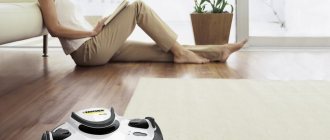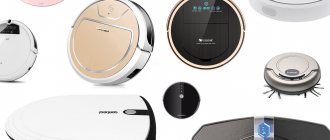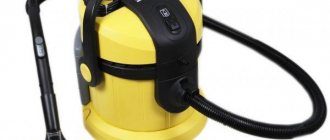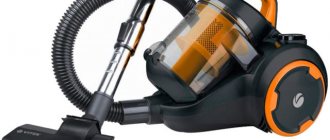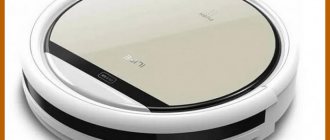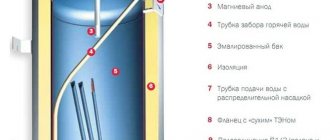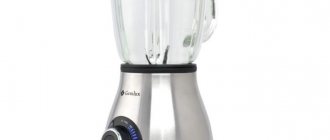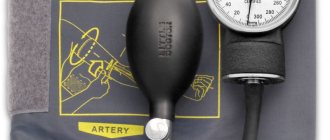In this review, we will look at the best models of Polaris robot vacuum cleaners. Let's get acquainted with their characteristics, find out how much they cost, consider their positive and negative sides. We will select the optimal models in terms of price/quality ratio.
The Polaris vacuum cleaner is a conscientious, reliable assistant for prompt and high-quality cleaning in your home. Robotic equipment is fully automated for cleaning work. The vacuum cleaner copes with the assigned tasks independently, although the process can be controlled by controlling it from the remote control.
Good operation of the unit is ensured by a powerful pump and a replaceable HEPA filter, which is endowed with antibacterial properties, eliminating the smallest particles of dust and microbes. The robot has a flat body for easy operation under beds or chairs. To program Polaris robotics, set the desired hour on the display, and a reliable assistant will clean the room of debris.
The device can independently select one of 5 modes:
- Manual. The device in this mode is controlled by a remote control.
- Auto. The vacuum cleaner chooses a route and moves randomly. Judging by the reviews, this method quickly drains the battery.
- Angular. Cleaning is done in corners and near baseboards.
- Spot. The gadget can more thoroughly clean a certain area of the surface if it is moved manually or directed by the control panel.
- Turbo. The robot moves at a faster pace and can remove more in a short period of time.
So…
Robot vacuum cleaner: Polaris PVCR 0926W EVO
Characteristics of Polaris PVCR 0926W EVO
| Are common | |
| Type | robot vacuum cleaner |
| Cleaning | dry and wet |
| Equipment | fine filter |
| Number of modes | 5 |
| Cleaning modes | local cleaning |
| Rechargeable | Yes |
| Battery type | Li-Ion, capacity 2600 mAh |
| Number of batteries | 1 |
| Installation on the charger | automatic |
| Battery life | up to 200 min |
| Charging time | 300 min |
| Sensors | infrared |
| Side brush | There is |
| Remote control | There is |
| Suction power | 22 W |
| Dust collector | without bag (cyclone filter) |
| Soft bumper | There is |
| Noise level | 60 dB |
| Dimensions and weight | |
| Vacuum cleaner dimensions (WxDxH) | 31x31x7.6 cm |
| Functions | |
| Timer | There is |
Pros and cons of Polaris PVCR 0926W EVO
Pros:
- large dust collector.
- wet cleaning.
- quiet.
Minuses:
- leaves dust in the corners.
- price.
Review from YAM about Polaris PVCR 0926W EVO
The impressions are twofold. On the one hand, a wonderful helper around the house. You sit on your couch, drink coffee, and he works for himself. On the other hand, for some reason this model is not cheap, but there is neither a display nor a virtual wall. And the situation with the black man was absolutely killing me! That is, now I either change the carpet, or a vacuum cleaner, or crawl on all fours again - clean the carpet, the question arises, why then is this miracle of technology, which cleans here, does not clean here?
Rating of the TOP 10 best Polaris robot vacuum cleaners of 2021
| Place | Name | Price |
| TOP 3 best Polaris robot vacuum cleaners by price/quality for 2021 | ||
| 1 | Polaris PVCR 1026 | Find out the price |
| 2 | Polaris PVCR 3200 IQ Home Aqua | Find out the price |
| 3 | Polaris PVCR 0930 SmartGo | Find out the price |
| TOP 3 best Polaris robotic vacuum cleaners with wet cleaning (washing) | ||
| 1 | Polaris PVCR 0926W EVO | Find out the price |
| 2 | Polaris PVCR 3300 IQ Home Aqua | Find out the price |
| 3 | Polaris PVCR 0826 | Find out the price |
| TOP 2 best Polaris robot vacuum cleaners with HEPA fine filter | ||
| 1 | Polaris PVCR 3000 Cyclonic PRO | Find out the price |
| 2 | Polaris VCR 0726W | Find out the price |
| TOP 2 best inexpensive Polaris robotic vacuum cleaners | ||
| 1 | Polaris PVCR 0316D | Find out the price |
| 2 | Polaris PVCR 1015 | Find out the price |
Robot vacuum cleaner: Polaris PVCR 1012U
Characteristics of Polaris PVCR 1012U
| Are common | |
| Type | robot vacuum cleaner |
| Cleaning | dry |
| Number of modes | 3 |
| Rechargeable | Yes |
| Battery type | Li-Ion, capacity 1200 mAh |
| Number of batteries | 1 |
| Installation on the charger | manual |
| Battery life | up to 100 min |
| Charging time | 180 min |
| Sensors | ultrasonic |
| Side brush | There is |
| Suction power | 18 W |
| Dust collector | without bag (cyclone filter), capacity 0.30 l |
| Soft bumper | There is |
| Noise level | 60 dB |
Pros and cons of Polaris PVCR 1012U
Pros:
- Can clean for quite a long time.
- price.
Minuses:
- It is necessary to constantly wipe the sensors.
- There is no low battery indicator.
- noise.
Video review of Polaris PVCR 1012U
Review from YAM about Polaris PVCR 1012U
I bought it, fully charged it, started it up. I liked everything, it removes dust, sand, small debris, hair very well (full dust collector), I was even surprised. It cleaned a short-pile carpet perfectly, but it did a worse job in the corners of the room and furniture. A full charge lasts about 40 minutes. On the second launch, some nonsense began. From a full charge it worked for 15 minutes, turned off, the red light came on (system error), turned it off and on, started it up, worked for another 5 minutes, got up again and so on 3 more times. The reason is unclear: it’s charged, the filter has been cleaned, everything looks fine outwardly. I’ll take it to the service center, I think it’s defective or someone has already returned it to the store and now they’ve brought it to me.
Conclusion
With their new robot, Polaris took a step towards their customers - the PVCR 3300 offers the same functionality as the PVCR 3200, but on more interesting terms. simplifying the design and making the battery cheaper can be considered an acceptable sacrifice to reduce the price to 26 thousand.
Polaris PVCR 3300 copes well with a smooth floor in a closed room and collects wool from carpets, but in a multi-room apartment, like most robots with a gyroscope, it experiences some difficulties in orientation.
Reviews of Polaris PVCR 3300 IQ Home Aqua
Robot vacuum cleaner: Polaris PVCR 0726W
Characteristics of Polaris PVCR 0726W
| Are common | |
| Type | robot vacuum cleaner |
| Cleaning | dry |
| Equipment | fine filter |
| Additional functions | liquid collection function |
| Driving Modes | along the walls |
| Cleaning modes | local cleaning (total number of modes: 5) |
| Rechargeable | Yes |
| Battery type | Li-Ion, capacity 2600 mAh |
| Number of batteries | 1 |
| Installation on the charger | automatic |
| Battery life | up to 200 min |
| Charging time | 300 min |
| Sensors | infrared |
| Side brush | There is |
| Display | There is |
| Remote control | There is |
| Power consumption | 25 W |
| Dust collector | without bag (cyclone filter), capacity 0.50 l |
| Soft bumper | There is |
| Dimensions and weight | |
| Vacuum cleaner dimensions (WxDxH) | 31x31x7.6 cm |
| Functions | |
| Alarm when jammed | There is |
| Timer | There is |
| Additional Information | HEPA 12 filter |
Pros and cons of Polaris PVCR 0726W
Pros:
- price.
- dry and wet cleaning.
- quiet.
Minuses:
- has trouble with carpeting.
- Doesn't clean well in one pass.
- Cleaning the dust container after each cleaning.
Video review of Polaris PVCR 0726W
Review from YAM about Polaris PVCR 0726W
When buying a vacuum cleaner, I also bought the so-called express service. After the breakdown, I exchanged it for a new one in the store using this express service, but…….you have to pay extra. I bought express service again for a new vacuum cleaner. It broke again, again replaced in the store with a new one and again purchased express service. Of course, during the warranty period it was possible to send it in for repairs for 30 days. I chose a replacement for a new one. I wanted to post a negative review on the seller’s website - they don’t post it, apparently you can only write laudatory reviews :)) The breakdowns were the same: the vacuum cleaner begins to move short distances, no further than a meter, and as if resting against an obstacle, it changes the direction of movement. Then again the movement is no further than a meter. So he moves only in short “rushes” almost in one place.
Robot vacuum cleaner Polaris PVCR 0726W: dry and wet cleaning
This robot is distinguished by a round, light body of small height and the presence of two side brushes that improve the quality of cleaning. In automatic mode, Polaris PVCR 0726W retracts, changing the movement algorithm, and returns to the base to charge the battery. In addition, the user can manually control the movement of the robot, turn on the intensive cleaning mode of a local area or the mode of following along the walls, and the robot can also be programmed to clean daily at a given time.
Content:
- Video review
- Specifications, delivery set and price
- Appearance and function
- Testing
- conclusions
Video review
To get started, we suggest watching our video review of the Polaris PVCR 0726W robot vacuum cleaner:
You can also watch our video review of the Polaris PVCR 0726W robot vacuum cleaner on iXBT.Video
Now let's take a look at the specifications of the device.
Specifications, delivery set and price
| Kinematic system | Two drive wheels and a support swivel roller |
| Dust collection method | Inertial movement and vacuum filtration |
| Dust collector | One compartment, capacity 0.5 l |
| Main brush | One with lint |
| Side brushes | Two |
| Additionally | Rubber scraper |
| Cleaning modes | Automatic until battery discharges, cleaning 30 minutes, local, along obstacles, manual, scheduled |
| Noise level | No data |
| Obstacle sensors | Mechanical front/side bumper, IR proximity and height difference sensors |
| Orientation sensors | IR base search sensors |
| Controls on the body | Mechanical button |
| Remote control | IR remote control |
| Alert | LED indicator and sound signals |
| Battery life | up to 200 min. |
| Charging time | up to 5 hours |
| Charging method | On a charging base with automatic return or directly from the power supply |
| Power supply | Li-ion battery, 14.8 V, 2600 mAh, 38.5 Wh |
| Power | 25 W |
| Weight | No data |
| Dimensions (diameter×height) | ∅310×76 mm |
| Contents of delivery |
|
| Link to manufacturer's website | www.polaris.ru |
| Average price according to Yandex.Market | T-13625419 |
| Offers based on Yandex.Market data | L-13625419-10 |
Appearance and function
The Polaris PVCR 0726W robot vacuum cleaner is packaged in a colorfully decorated cardboard box with a calm white background.
The box has typical dimensions for such devices. It is equipped with a plastic handle, so it will not be difficult to carry your purchase home. The delivery set includes almost all the accessories necessary for the robot to operate, and only AAA batteries for the remote control will have to be purchased.
Spare parts and consumables included in the package include a replaceable folded filter of the last stage, a set (right and left) of side brushes and two cloths (apparently made of microfiber) for wet cleaning. There is also a combination brush-comb that can be used to clean the dust collector, the robot itself, and the main brush in particular. The user manual is a booklet of several pages. The manual is, of course, in Russian. The quality of text and printing is quite high. A PDF version of the manual can be downloaded from the Polaris website.
The robot body is made of two types of plastic - black (bottom) and white (top) with a matte surface. The option is non-staining, and the predominantly light color of the body makes it easier to find the robot in the dark corners of the apartment when for some reason it does not return to base; it is also easier to notice the robot with peripheral vision when it gets underfoot, which means it is less likely to be attacked come on. The upper part of the body is covered with a thick plate of transparent and relatively damage-resistant plastic. Under the plate there is a golden-colored coating. On the top panel towards the front there is a single mechanical button with the word Auto and a power icon illuminated.
Depending on the current status, this indicator glows solid green or flashes orange (charging) or red (error). The brightness of the indicator is moderate, and since the button coating is silver and reflects everything, it is sometimes difficult to see in the light what kind of condition it is. Additionally, the robot informs about its condition using short and not very loud sound signals. You cannot turn off the sound notification. The vacuum cleaner has an almost perfectly round shape with a diameter of 306 mm (hereinafter in the text the results of our measurements are given). The bottom edges are beveled, which helps the robot overcome obstacles, and some angularity in the transition from the top panel to the side surface and a lip on the bumper at the top reduce the likelihood that the vacuum cleaner will get stuck under obstacles with little clearance.
The robot's mass is 2.6 kg. The axes of the driving wheels are located on the same diameter of the body circumference, this allows the robot to turn on the spot without changing the boundaries of the area it occupies. A positive role is played by the relatively small height of 77 mm (along the side of the bumper) and the body, which is smooth around the perimeter. The drive wheels with a diameter of 65 mm are equipped with grippy rubber tires with pronounced lugs. The wheels are mounted on spring-loaded joints with a travel of 27 mm, which also improves the robot's ability to overcome obstacles. True, the lower part of the bumper is at a height of 17 mm from the floor - the robot cannot overcome obstacles higher. A spring-loaded bumper with a small stroke goes around the entire front half of the body.
Shifting the bumper triggers mechanical obstacle sensors. To protect furniture from the front, a strip of medium-hard rubber is glued to the lower part of the bumper. Higher up on the bumper behind a tinted plastic window are IR obstacle detection sensors, a base station and, possibly, a command receiver from the remote control. Some of the above are apparently also located behind the tinted windows on the body behind the bumper closer to the back of the vacuum cleaner. By pressing the latch at the back, you can detach the dust collector from the robot body.
The body of the dust collector is made of tinted transparent plastic, but this does not bring much benefit, since you can only see something in the dust collector either by turning the vacuum cleaner upside down or by removing the dust collector. The front partition in the dust collector is of sufficient height so that when carefully manipulating it, debris does not fall out of the closed dust collector. The upper part of the dust container tilts to a large angle, which makes it easy to shake out heavy debris from the lower part. For complete cleaning, remove the pre-screen filter, shake off any light debris, and clean the foam filter and pleated fine filter if necessary.
It is convenient to perform these operations, as well as empty the dust container, using a conventional vacuum cleaner with a crevice nozzle. Just be careful not to suck in the thin foam filter. From our point of view, such a multi-stage filtration system is redundant and only reduces the air flow; one mesh filter would be enough. In any case, foam rubber is definitely superfluous. However, during the tests, a lot of light debris was collected on the first filter (and this was from a clean floor), which means that the suction power, even with all the filters, is relatively high. Note that there is no fan in the dust collector itself, so the dust collector and filters can be washed under water, the main thing is to dry everything well afterwards. It is recommended to change the folded fine filter after 6 months of use. The side brushes have long and stiff bristles, tufts of which emerge from elastic leads. Let us remind you that side brushes that have lost their shape can be straightened by smoothing out the tufts of bristles under hot water and drying the brushes before installing them in place. The right and left brushes differ in the rotation of the leads, and so that the user knows which one to install where, the letters L
and
R.
_ The brushes are attached to the drive axis using a self-tapping screw with a Phillips head screwdriver. The shaft of the main brush is smooth, of relatively large diameter and with longitudinal grooves - this makes it easier to free the shaft simply with your fingers without the help of tools from threads, hair and other things that have been wound up. The bristles on this brush are of medium hardness, and their tufts are wavy, which reduces the sound from the rotation of the brush in contact with the floor. The steel axis at the end of the brush rotates in a sliding bearing in the form of a bronze bushing. This is the right design decision, since the rolling bearings in this unit sooner or later jam due to hair, wool, etc., wrapped around the cage. The brush in the compartment is fixed with a yellow plastic frame. This frame has a rubber scraper that helps the brush pick up debris from the floor and throw it into the dust bin.
Note that the drive gears of the brushes and wheels allow them to be rotated by hand; this is very helpful when you need to pull the robot out, for example, from under a sofa under which it is stuck, or to untangle something wrapped around the wheels or brushes. When cleaning, the front side brushes scoop up debris to the center, then the main brush throws debris into the dust bin, and the air flow helps suck the lightest debris into the dust bin. Elastic gaskets along the entire path from the inlet of the dust collector to the fan eliminate parasitic air suction past the filters and dust collector.
For wet cleaning of smooth floors, instead of a regular dust collector, you can install the special container included in the delivery package. A terry cloth is attached to the bottom of the container with Velcro and two elastic bands.
The napkin can be pre-moistened, and to keep it moist, you need to pour water or a detergent solution into the container reservoir.
The liquid seeps onto the napkin through porous inserts in the bottom of the tank. This container also has a small compartment for garbage, where the main brush throws it, however, the fan is no longer involved in collecting garbage, since the inlet pipe is blocked by the wall of the container.
On the right side there is a power connector for direct charging of the battery and a button that disconnects the battery from the robot circuits.
This robot has a lithium-ion battery. The battery pack is made up of four cylindrical cells of the popular 18650 size.
On the bottom there are two contact pads, a front support swivel roller, side brushes, a battery compartment cover, two drive wheels, and a main brush compartment. Closer to the edge, just behind the bumper, there are three IR height difference sensors, thanks to which the robot vacuum cleaner can avoid falling down the steps.
Note that this robot worked without problems on a black carpet, while in most other robots the height difference sensors had to be deactivated so that the robots did not consider the black floor to be a failure into nowhere. The front roller is made of black elastic plastic alternating with white and hard. This was done for a reason, but so that the robot, using an optical sensor located under the roller, could determine whether it is moving during cleaning or not, that is, stuck. However, during testing, we did not find any reliable signs that information about the rotation of the video is being used in any way.
The base on which the vacuum cleaner is charged has a relatively large base, onto which four anti-slip rubber feet are glued to the bottom.
The base is powered by an external power adapter, which can also be used to charge the robot, bypassing the base if for some reason it is unavailable.
The vacuum cleaner comes with a small IR remote control.
The remote control buttons are made of elastic rubber-like material; the markings on the buttons are quite large and contrasting. The screen on the front of the remote control shows the current time and the time at which cleaning is scheduled to start automatically.
The Polaris PVCR 0726W robot vacuum cleaner has five cleaning modes:
Auto mode
until the battery is almost completely discharged, while the robot moves in a straight line from obstacle to obstacle, randomly changing direction after a collision, and follows the walls for some time. These options are cycled through. This mode is activated by pressing the Clean button on the remote control or the Auto button on the robot itself. This mode is also used during scheduled cleaning. Having completed cleaning, the robot returns to the base to charge the battery.
Automatic cleaning, but limited to 30 minutes
It is turned on by double pressing the Clean button on the remote control or the Auto button on the robot itself. Looking ahead, we note that we were unable to enable this mode.
In manual mode
When cleaning, the direction of movement of the robot is set using the buttons on the remote control. If you first start the robot for cleaning in automatic mode, the robot turns in place at a fixed angle when you press the right-left arrows on the remote control, turns around when you press the down arrow, but cleans and continues to move straight even after the button is released. If you do not start the robot to clean, it stops after the maneuver and moves forward until it collides with an obstacle after pressing the forward arrow, cleaning in motion.
For intensive cleaning
To reach a certain place, you need to move the robot there or direct it to the desired place in manual control mode, and then press the button with the spiral icon on the remote control. The robot will begin cleaning in an unfolding and then collapsing spiral in a circle approximately one meter in diameter.
Another cleaning option is to move only along walls and obstacles. This mode is activated by a button on the remote control with an icon of arrows and a square.
It is possible to schedule a daily start of cleaning in automatic mode for a specific time. To do this, you need to set the current time and the start time of cleaning on the remote control, monitoring by sound signals that the timers of the robot and the remote control are synchronized.
Testing
Below are the test results using our methodology, described in detail in a separate article.
| Mode | Total cleaning time, min. | % |
| First 10 min. | 10 | 83,5 |
| Second 10 min. | 20 | 90.3 (total) |
| Third 10 min. | 30 | 93.2 (total) |
| Further until the battery is discharged | 150 | 97.3 (total) |
The video below was shot from one point with almost complete coverage of the area being cleaned, the base is located at the bottom center, during processing part of the video sequence was accelerated ten times, only the beginning of cleaning is shown (the first 10 minutes):
The quality of cleaning is high. Even after 10 minutes, the robot collects a lot of garbage, and after 30 minutes of operation there is very little garbage left, mainly near the base:
Cleaning in the test room until the battery ran out showed that the robot was able to remove almost all the garbage in the area accessible to it.
There is a little rice left in the corners and near the base:
The pen is only 5 cm wider than the robot, but this did not stop the robot from driving there several times and cleaning it well. Video of parking at the base after the return command:
If there is no command to park from the user, then, having almost completely discharged the battery, the robot turns off the fan and, apparently, the main brush, slightly reduces the speed and begins to search for the base. In fact, it appears that the robot has a two-hour limit on how long it can run continuously, so the robot starts searching for a base either because the battery is too low, or when two hours have passed since it started cleaning. The robot handles the base very carefully, maybe even too carefully, does not push or move, but also goes around it far, leaving some debris near it. The robot parks confidently, and in our tests it always does so the first time. There is usually a small gap between high vertical walls that reflect IR rays well and the body of the robot, while the robot approaches low, inclined (for example, a baseboard) or walls that are black in IR light until the mechanical sensor in the bumper is triggered. According to our tests, the robot removes 150
minutes, and it needs to spend about
4
hours on the base to restore the charge. During charging from the network, it consumes from 14 W at the beginning to about 2 W at the end. 1.2 W is consumed with the robot on the base in standby mode and 0.6 W is consumed by the base without the robot.
In local cleaning mode, the robot cleans in an unfolding and then collapsing spiral. The video below demonstrates this (at one point the height difference sensor still went off on the black carpet):
The mode of cleaning along an obstacle in this case is implemented strangely, since even if the robot moves along the wall, it only does so for a few seconds, after which it continues cleaning as usual, and if suddenly a base is discovered, the robot immediately parks on it.
Testing in wet cleaning mode with a special container installed showed that one refill with liquid is enough for about an hour of work. The robot's footprint is slightly damp and dries quickly. A little debris collects in the compartment in front of the container, and the napkin becomes dirty over the entire area, which indicates its uniform pressure.
Note that, from our point of view, in this mode it is worth cleaning very smooth floors with a pattern that masks stains; also, before wet cleaning with this robot, the floors need to be thoroughly cleaned of debris (by the same robot, for example), since wet debris forms a crust that is difficult to remove, sticks to the walls of the brush compartment and container compartment.
During cleaning, regardless of the mode, the robot makes the same noise.
| Mode | Noise level, dBA |
| Local | 56 |
The robot is relatively quiet. The nature of the noise it makes is not annoying; being in the same room with a working robot is more or less comfortable. For comparison, the noise level under these conditions of a conventional (not the quietest) vacuum cleaner is approximately 76.5 dBA.
conclusions
In automatic mode, the Polaris PVCR 0726W robot vacuum cleaner can perform both dry and wet cleaning. For the second option, instead of the usual one, you need to install a special container in which there is a reservoir for liquid, and a cleaning cloth should be attached to the bottom of the container, which is moistened with liquid from the reservoir during cleaning. Having completed cleaning, the robot itself returns to the base to charge the battery. The user can manually control the robot's movement, turn on an intensive cleaning mode for a local area, and program the robot to clean every day at a specified time. Note the relatively high suction force, which, with the assistance of two side brushes with long bristles on elastic leads and the main brush, facilitates the effective collection of both light and heavy debris with good width coverage in one pass.
Advantages:
- Quiet operation
- A special container for wet cleaning and two napkins for it
- Effective side brushes
- Easy-to-use dust collector
- The main brush is easy to clean
- Good equipment
Flaws:
- No significant
Comparison of Polaris robot vacuum cleaners
| Polaris PVCR 0926W EVO | Polaris PVCR 1012U | Polaris PVCR 0726W | |
| Price | from 16,500 rubles | from 7,000 rubles | from 17,000 rubles |
| Type of cleaning | dry and wet | dry | dry |
| Suction Power(W) | 22 | 18 | — |
| Equipment | fine filter | — | fine filter |
| Dust container volume (l) | — | 0.3 | 0.5 |
| Sensors | infrared | infrared | infrared |
| Number of driving modes | 5 | 3 | — |
| Movement along the walls | ✓ | — | ✓ |
| Alarm when jammed | — | — | ✓ |
| Local cleaning | ✓ | — | ✓ |
| Display | — | — | ✓ |
| Installation on the charger | automatic | manual | automatic |
| Remote control | ✓ | — | ✓ |
| Battery life (min) | 200 | 100 | 200 |
| Noise level (dB) | 60 | 60 | — |
| Electric brush included | ✓ | — | ✓ |
| Height (cm) | 7.6 | — | 7.6 |
| Possibility of connecting an electric brush | — | — | ✓ |
| Timer | ✓ | — | ✓ |
Comparison of the best Polaris robot vacuum cleaners
The table below examines the 10 best models of Polaris robotic vacuum cleaners that have proven themselves to be the best.
| Model | Container type | Type of cleaning | Battery operating time, min | Design Features | price, rub. |
| PVCR 0920WV | For dust 0.30 l and for water 0.20 l | Dry and wet | 100 | Built-in clock, timer, backlit display, remote control, soft bumper, fine filter | 12000 — 20100 |
| PVCR 0726W | For dust 0.50 l | Dry | 200 | Liquid collection function, 5 cleaning modes, local cleaning, timer, remote control, soft bumper | 12900 — 19900 |
| PVCR 0826 | For dust 0.20 l and for moisture 0.30 l | Dry and wet | 200 | Automatic moistening of wet cleaning cloth, built-in clock, timer, remote control, soft bumper, fine filter, local cleaning | 13100 — 21000 |
| PVCR 0926W EVO | For dust 0.20 l and for moisture 0.30 l | Dry and wet | 200 | Timer, remote control, soft bumper, fine filter, local cleaning | 12800 — 16000 |
| PVCR 1020 FusionPRO | For dust 0.50 l | Dry | 120 | HEPA filter + primary filter kit, charging base, side brushes, charger, remote control, turbo brush, programming by days of the week | 12100 — 18500 |
| PVCR 1090 Space Sense Aqua | For dust 0.50 l and for water 0.30 l | Dry and wet | 120 | Fast and local cleaning, timer, remote control, fine filter, automatic installation on the charger | 15200 — 21300 |
| PVCR 1012U | For dust 0.30 l | Dry | 100 | Soft bumper, manual installation on the charger, ultrasonic sensors, 3 driving modes | 6300 — 9500 |
| PVCR 0510 | For dust 0.20 l | Dry | 55 | Soft bumper, infrared sensors, fine filter, Ni-MH battery | 6200 — 9300 |
| PVCR 0930 SmartGo | For dust 0.20 l and for water 0.30 l | Dry and wet | 130 | Anti-fall sensor, SmartDrop water supply control technology, IQ-Action inverter motor, building a room map, signal when stuck, built-in clock, timer, remote control, display | 21200 — 28400 |
| PVCR 3000 Cyclonic PRO | For dust 0.60 l | Dry | 120 | Local cleaning, programming by days of the week, timer, display, remote control, soft bumper, fine filter, building a room map | 24300 — 32000 |
